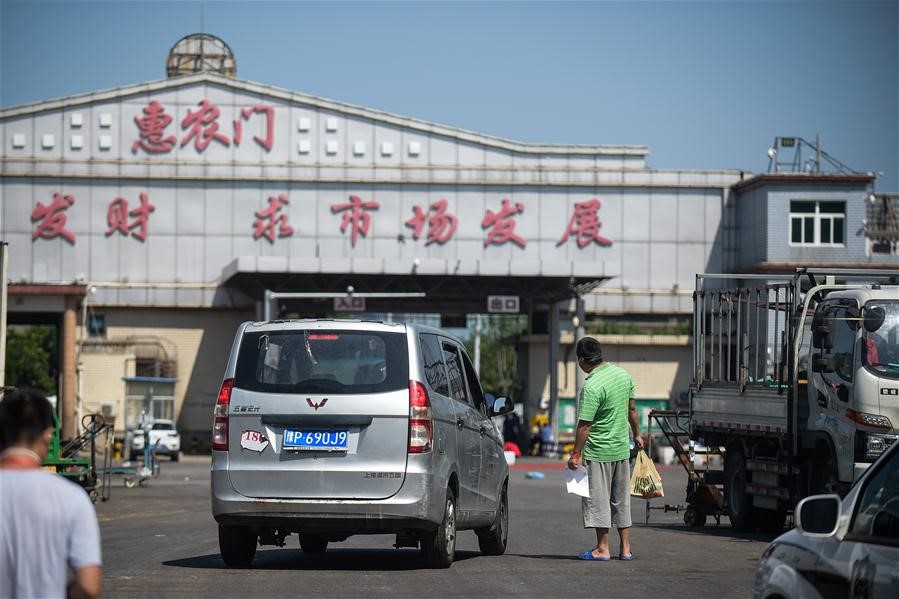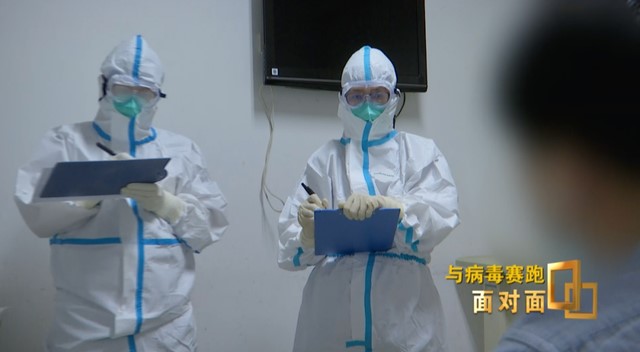
A vehicle driven by a man who has completed quarantine leaves the Xinfadi market in Beijing, capital of China, July 7, 2020. (Photo/Xinhua)
For 52-year-old Beijing resident Tang, July 14 was a memorable day. After 33 days of treatment for COVID-19, he was finally discharged from hospital. As Beijing’s new “patient zero”, Tang gained nationwide attention online, with many sending him best wishes for his recovery and lauding him for what he did to help Beijing respond to the outbreak.
More than a month ago, Tang was found to have contracted COVID-19, breaking a 56-day run of no new local infections in Beijing. It took Beijing authorities less than 24 hours from the discovery of the first confirmed case to the identification of the source of the epidemic, and Tang’s contribution played no small part in that achievement.
Nicknamed by Chinese media and netizens as “the Grandpa of Xicheng” after the district in which he lives, Tang is a textbook example of what to do after experiencing COVID-19 symptoms, which bought Beijing precious time to bring the outbreak under control.
After feeling cold and exhausted, besides going to the hospital alone on a bike and wearing a mask right to reduce the risk of infecting others, Tang clearly recalled all the places he had visited and people he had come into close contact with since May 31, providing key information for the quick identification of the source of the infection. Netizens say Tang has a “super brain”.
Retracing his steps

CDC staff carry out an epidemiological survey with Tang.
The potential of Tang’s “super brain” was partly tapped by Beijing’s Center for Disease Control and Prevention (CDC). Right after Tang arrived at Xuanwu Hospital for isolation as required at 1:00 a.m. on June 11, staff from Xicheng District’s CDC rushed to the hospital overnight to carry out an epidemiological survey to trace the source and earlier close contacts.
Fully tracing his movements over the past two weeks was no easy task, and staff tried their best to jog his memory. Dou Xiangfeng, an on-duty physician at Beijing CDC’s Institute for Infectious Disease and Endemic Disease Control, said they first got Tang to recollect some of his main activities over the past few days, and then helped him recall more details with the help of payment records, chat records, and navigation records on his mobile phone.
A supplementary epidemiological investigation was carried out by Dou and his colleagues in the morning to obtain further details.

52-year-old Tang in Beijing gives a thumbs up to the camera during treatment at Xuanwu Hospital.
For example, when Tang said he had taken his child to the playground, staff asked him what he did when his child was playing. Tang then remembered he played billiards at a billiard room. The staff then asked whether he set the table himself or whether a waiter set it for him, and whether there was anyone else playing near him.
When Tang couldn’t recall the exact time when he was present at certain places, they helped by checking his payment records on his phone. The location of specific stalls where he bought goods could also be tracked.
“Supported by payment records, we got a clear picture of the whole process,” Dou recalled. “We admire him so much for his excellent memory.”
Identifying the source in 24 hours

Staff collect environmental samples at Xinfadi market. (Photo/Beijing Daily)
Finally, the CDC compiled a detailed list of 38 people with whom he had close contact and 23 places he had visited, including the beef and mutton trading hall in Xinfadi. The CDC immediately screened and quarantined all close contacts and conducted on-site environmental sampling in those places.
On the night of June 11, another person tested positive for COVID-19, and the same hall at Xinfadi market once again appeared on the report of the epidemiological survey. A few hours later, CDC found positive test results in environmental samples taken from the hall at the market, indicating that it was highly suspected to be the source of the virus.
Beijing CDC and nine district CDCs then rushed to Xinfadi market to carry out a thorough sampling of the environment and workers. Forty environmental samples and 45 throat swabs tested positive that day.
At 3:00 a.m. on June 12, about 22 hours after Tang was found to have contracted COVID-19, Xinfadi market was put under lockdown.
Wang Quanyi, Director of Beijing CDC's Institute for Infectious Disease and Endemic Disease Control, said Beijing’s actions were science-based in this race against the virus.
“There were 12,000 people in the market. If the lockdown had been just one day late, many of them would have left Beijing. In that case, it would have been much more difficult to control the outbreak,” noted Dou.
Maintaining regular controls

On-site sampling at Xinfadi market. (Photo/Beijing Daily)
The number of newly confirmed COVID-19 cases reached a peak in Beijing on June 13 and 14 and then started generally declining. On June 18, China’s chief epidemiologist Wu Zunyou announced that the epidemic situation in Beijing was under control. On July 19, no new cases in Beijing had been reported for 14 consecutive days, and the city announced it was lowering its emergency response to COVID-19 from level II to III starting July 20. Beijing’s success in containing the new outbreak was attributed to the “super brain” of the “Grandpa of Xicheng”, as well as the timely and precise prevention and control measures implemented by local authorities.
On July 14, Tang was discharged from the hospital. “Our country has made great efforts and responded quickly to the outbreak with precise treatment and accurate virus tracing,” Tang said, expressing gratitude fo the hard work of medics and experts.
“The lights of the CDC laboratories haven’t been off since Jan. 1,” said Wang, noting that his colleagues have been working with a sense of responsibility and mission. Looking back on Beijing’s response to the new outbreak, Wang said, “My team and I have done our work without guilt.”
Following the downgrading, the city will continue to stick to the strategy of preventing imported cases and local resurgences, said Chen Bei, deputy secretary-general of the Beijing municipal government.
(People's Daily Online)







